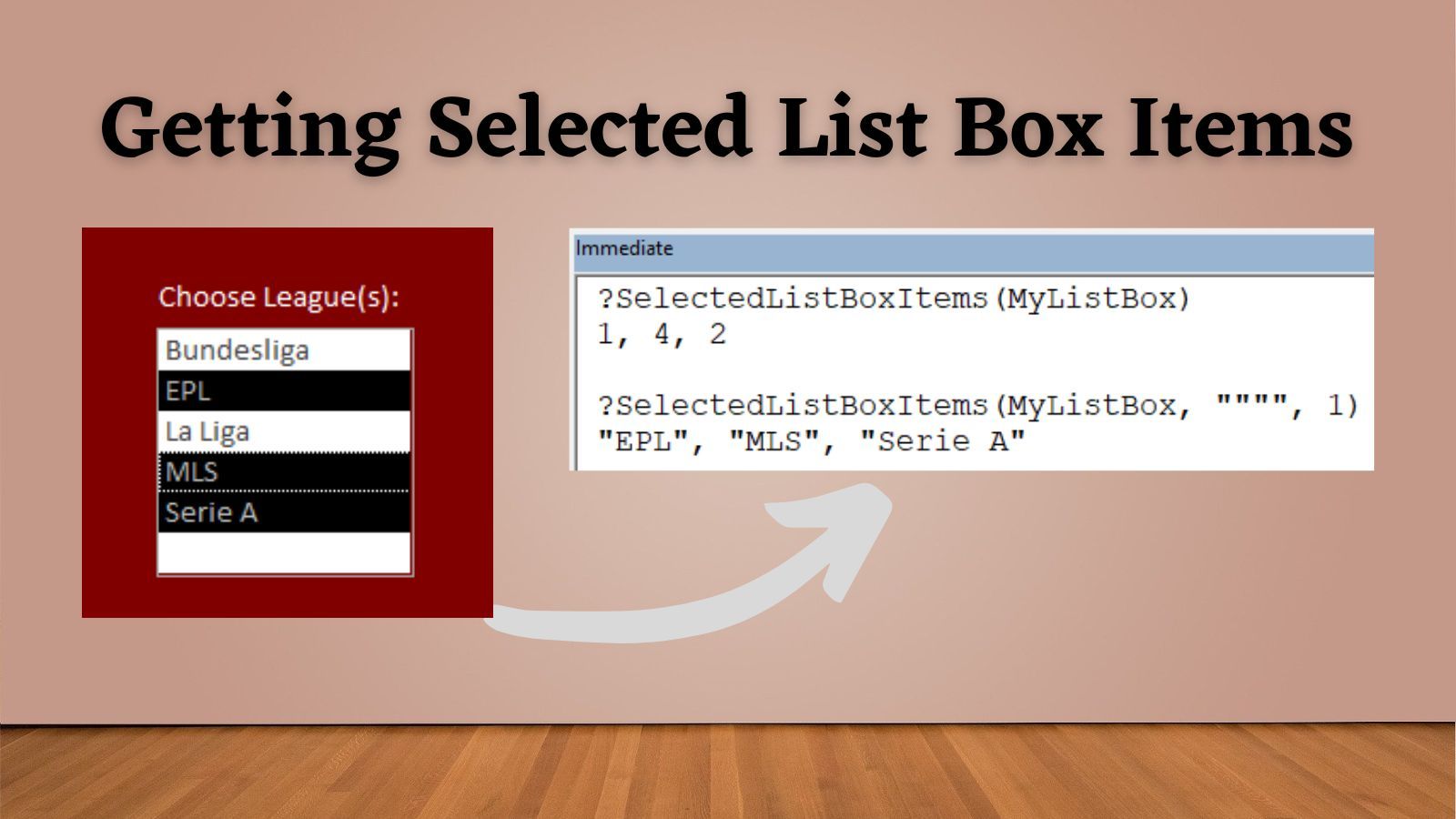SelectedListBoxItems() Function
It's not difficult to get the selected items from a multi-select list box, but it is tedious. This function makes it simple and easy.

UPDATE [2022-07-15]: Please see my follow up article, IMPROVED: SelectedListBoxItems() Function, for a newer version of this function that incorporates Laurent Meus's comment below.
So you've got a multi-select list box that you want to use to filter a report, but how do you get the list of values that the user selected?
Brief Example
Here's a sample table of some soccer leagues from around the world:

Let's say you wanted to let your users choose one or more of the above leagues to filter a report to show only the teams from the selected league(s). The easiest way to do that is with a multi-select list box control. It's perfect for lists with fewer than ten items or so.

The list box above has two columns:
- LeagueID (hidden)
- LeagueName
Its "Multi Select" property is set to Extended, though Simple would work equally well.
Getting the selected values from such a list box control isn't hard, but I had to look up the properties I needed to use every time the situation came up. I finally got tired of doing that, so I wrote a quick function to make the task simpler (and create more readable code).
Immediate Window Usage
The function returns a comma-delimited list of selected items from a list box.

By default, it will return the values from the first column with no delimiter. In a typical list box where the AutonumberID is the first (hidden) column, this is what we usually want.
Sometimes, though, we want to return the text values. That's where the two optional parameters come in:
Wrapper: which is generally a blank string ("") for numeric fields,"#"for date fields, and an escaped double quote ("""") for string fieldsColumnNum: remember that column numbers in list boxes are 0-based, so the second column isColumnNum:= 1.
Real World Usage
If the user can filter the values that appear in the reports, I like to show a human-readable note in the header to indicate which values are included in the report. I often use the OpenArgs argument of the OpenReport method to pass that sort of information.
Here's a full sample of the kind of code I might write in the click event of a soccer team report preview button that relies on the list box shown above:
Private Sub btnShowReport_Click()
Dim InList As String
InList = SelectedListBoxItems(Me.lbLeaguePicker)
Dim WhereClause As String
WhereClause = "LeagueID In (" & InList & ")"
Dim Leagues As String
Leagues = SelectedListBoxItems(Me.lbLeaguePicker, """", 1)
'see: https://nolongerset.com/previewreport-function/
PreviewReport "SoccerTeams", WhereClause, Leagues
End Sub
The Code
As a periodic reminder, you generally won't see error-handling boilerplate in my code because I use Wayne Phillips's excellent vbWatchdog global error handler.
'---------------------------------------------------------------------------------------
' Procedure : SelectedListBoxItems
' Author : Mike Wolfe
' Source : https://nolongerset.com/selectedlistboxitems/
' Date : 12/14/2012
' Purpose : Returns a comma delimited list of selected items from a list box.
' Notes - Wrapper generally "" for numeric, "#" for dates, and """" for strings.
'---------------------------------------------------------------------------------------
'
Function SelectedListBoxItems(LBox As ListBox, _
Optional Wrapper As String = "", _
Optional ColumnNum As Integer = 0)
Dim Row As Integer, s As String, CurItem As String
For Row = 0 To LBox.ListCount - 1
If LBox.Selected(Row) Then
CurItem = Wrapper & LBox.Column(ColumnNum, Row) & Wrapper
s = Conc(s, CurItem)
End If
Next Row
SelectedListBoxItems = s
End Function
'The Conc() function concatenates two strings without needing to strip
' off the leading/trailing delimiter
'Source: https://nolongerset.com/come-together/
Private Function Conc(StartText As Variant, NextVal As Variant, _
Optional Delimiter As String = ", ") As String
If Len(Nz(StartText)) = 0 Then
Conc = Nz(NextVal)
ElseIf Len(Nz(NextVal)) = 0 Then
Conc = StartText
Else
Conc = StartText & Delimiter & NextVal
End If
End FunctionReferenced articles



